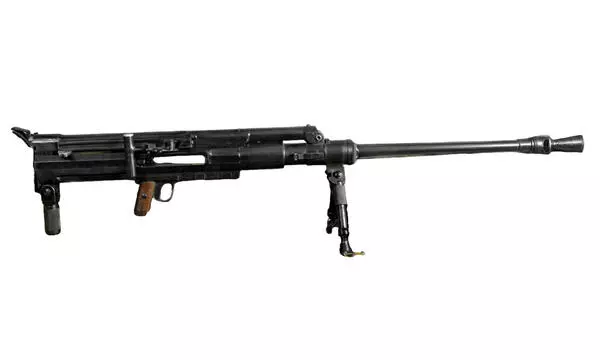The exhibition of the Victory Museum includes a German machine gun. The MG 34 was the first general-purpose machine gun adopted into service. It was developed by the weapons designer Louis Stange. The idea was based on the experience of the German armed forces in World War I. A universal machine gun could serve both as a bipod-mounted light machine gun, and a medium machine gun used by a squad or mounted on an anti-aircraft tripod. It could also be installed on tanks and armored vehicles in single or multiple-gun arrangements.
Like other German weapons, the MG 34 was designed in Switzerland to evade the limitations of the Treaty of Versailles. The treaty imposed tight restrictions on the production of weapons in Germany after World War I.
The introduction of the general-purpose machine gun facilitated the supply of equipment and the training of personnel, while also improving tactical indicators. The users could fire both single shots and bursts. The machine gun also provided anti-aircraft coverage, facilitating the operations. For this purpose, it could be installed on an anti-aircraft tripod.
The weapon also had the advantages of having a magazine and an optical sight. In the light machine gun role, it required a three-man squad consisting of a machine gunner and two ammunition carriers.
The machine gun was adopted for service in 1934. The demand was so high that by 1939, the Germans had produced over eighty thousand units. MG 34 was the mainstay of German infantry and armored forces until the end of World War II.
At the same time, the trigger mechanism was rather complicated, and the barrel could overheat quickly. These drawbacks slowed down the production of weapons which was unacceptable during the war. To improve the machine gun, its design was modified, with the new model named MG 42 and adopted into use in 1942. However, the production of the MG 34 continued because it was more efficient as a tank-mounted machine gun.
Like other German weapons, the MG 34 was designed in Switzerland to evade the limitations of the Treaty of Versailles. The treaty imposed tight restrictions on the production of weapons in Germany after World War I.
The introduction of the general-purpose machine gun facilitated the supply of equipment and the training of personnel, while also improving tactical indicators. The users could fire both single shots and bursts. The machine gun also provided anti-aircraft coverage, facilitating the operations. For this purpose, it could be installed on an anti-aircraft tripod.
The weapon also had the advantages of having a magazine and an optical sight. In the light machine gun role, it required a three-man squad consisting of a machine gunner and two ammunition carriers.
The machine gun was adopted for service in 1934. The demand was so high that by 1939, the Germans had produced over eighty thousand units. MG 34 was the mainstay of German infantry and armored forces until the end of World War II.
At the same time, the trigger mechanism was rather complicated, and the barrel could overheat quickly. These drawbacks slowed down the production of weapons which was unacceptable during the war. To improve the machine gun, its design was modified, with the new model named MG 42 and adopted into use in 1942. However, the production of the MG 34 continued because it was more efficient as a tank-mounted machine gun.




